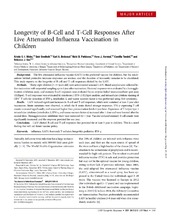Longevity of B-cell and T-cell responses after live attenuated influenza vaccination in children
Mohn, Kristin Greve-Isdahl; Bredholt, Geir; Brokstad, Karl Albert; Pathirana, Rishi; Aarstad, Hans Jørgen; Tøndel, Camilla; Cox, Rebecca Jane
Peer reviewed, Journal article
Published version
Permanent lenke
https://hdl.handle.net/1956/9875Utgivelsesdato
2015-05-15Metadata
Vis full innførselSamlinger
Originalversjon
Journal of Infectious Diseases, 2015. 211 (10), 1541–1549. https://doi.org/10.1093/infdis/jiu654Sammendrag
Background. The live attenuated influenza vaccine (LAIV) is the preferred vaccine for children, but the mechanisms behind protective immune responses are unclear, and the duration of immunity remains to be elucidated. This study reports on the longevity of B-cell and T-cell responses elicited by the LAIV. Methods. Thirty-eight children (3–17 years old) were administered seasonal LAIV. Blood samples were collected before vaccination with sequential sampling up to 1 year after vaccination. Humoral responses were evaluated by a hemagglutination inhibition assay, and memory B-cell responses were evaluated by an enzyme-linked immunosorbent spot assay (ELISpot). T-cell responses were evaluated by interferon γ (IFN-γ) ELISpot analysis, and intracellular cytokine staining of CD4+ T cells for detection of IFN-γ, interleukin 2, and tumor necrosis factor α was performed using flow cytometry. Results. LAIV induced significant increases in B-cell and T-cell responses, which were sustained at least 1 year after vaccination. Strain variations were observed, in which the B strain elicited stronger responses. IFN-γ–expressing T cell counts increased significantly, and remained higher than prevaccination levels 1 year later. Expression of T-helper type 1 intracellular cytokines (interleukin 2, IFN-γ, and tumor necrosis factor α) increased after 1 dose and were boosted after the second dose. Hemagglutination inhibition titers were sustained for 1 year. Vaccine-induced memory B cell counts were significantly increased, and the response persisted for one year. Conclusions. LAIV elicited B-cell and T-cell responses that persisted for at least 1 year in children. This is a novel finding that will aid future vaccine policy.

